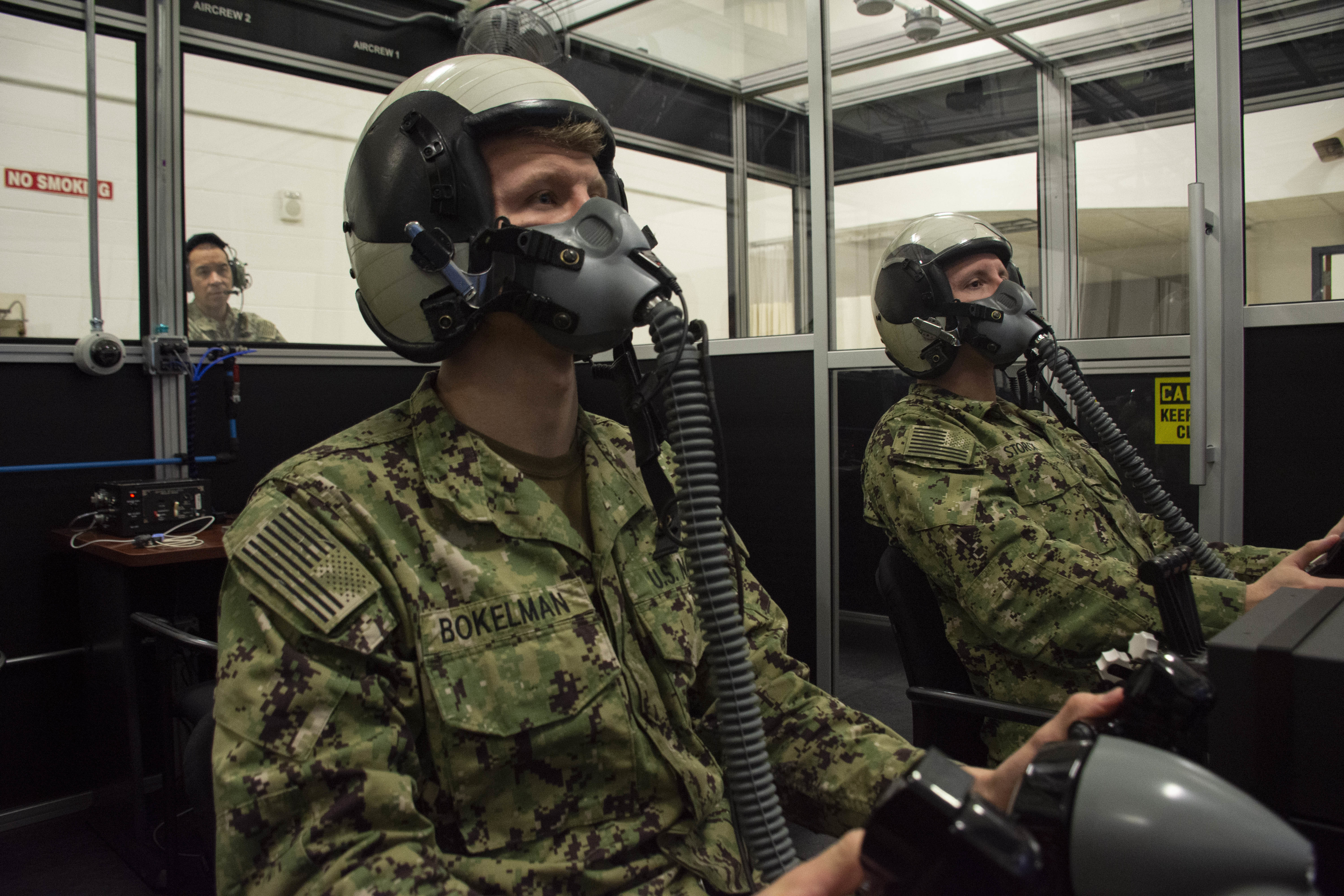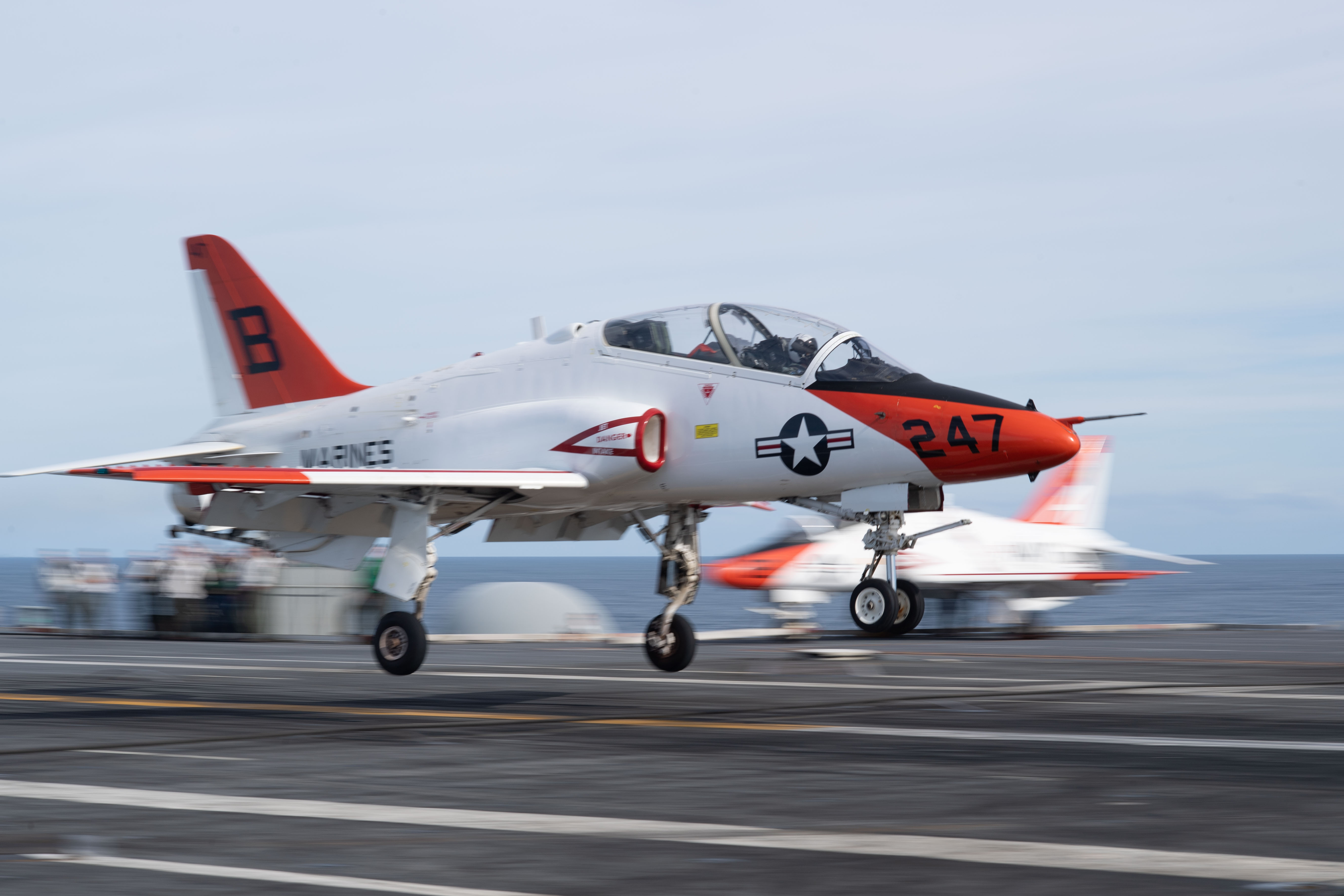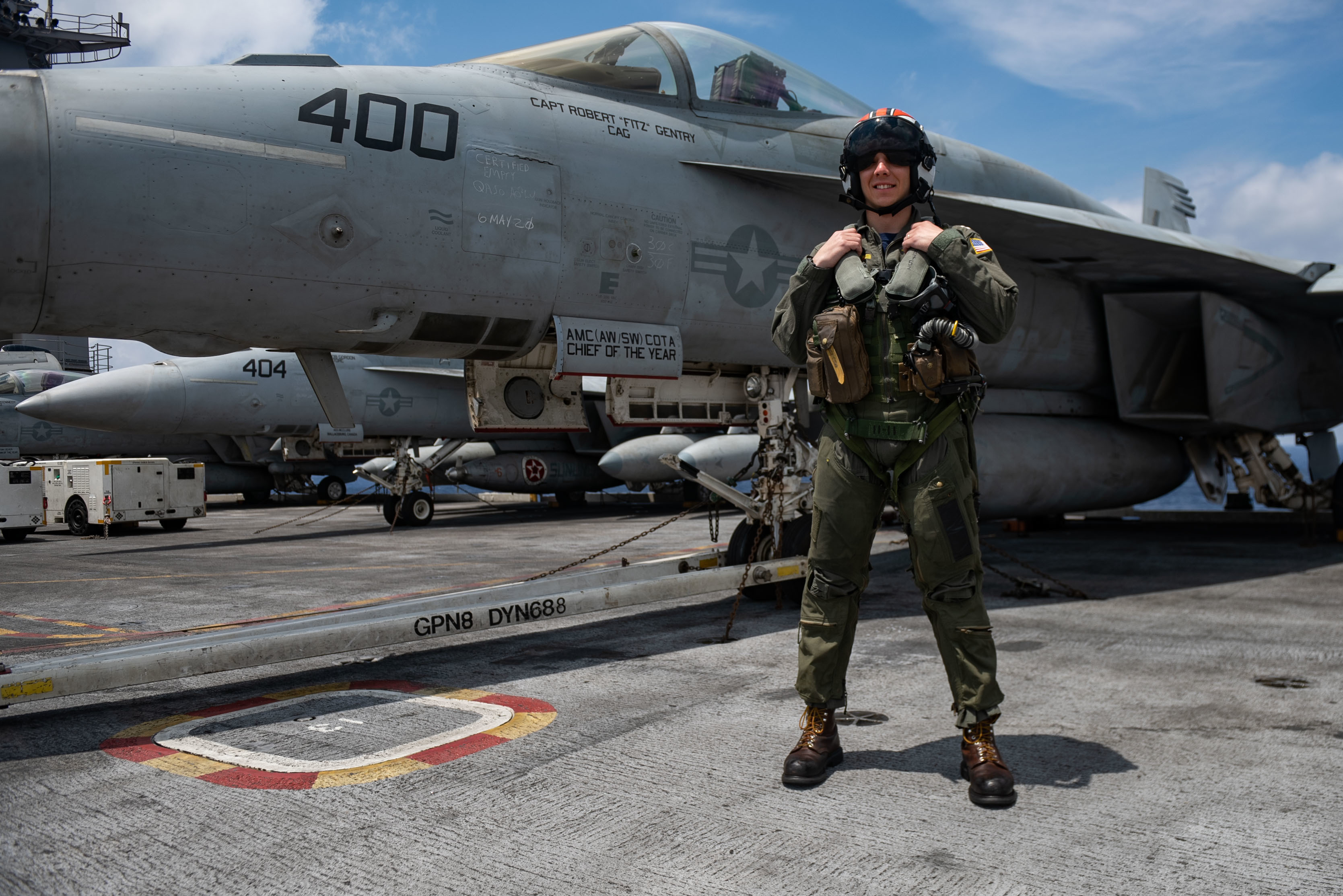Lt. Joshua Chester, a Navy pilot from Lorton, Virginia, poses in front of an F/A-18E Super Hornet, assigned to the “Sunliners” of Strike Fighter Squadron (VFA) 81 on the flight deck of the Nimitz-class aircraft carrier USS Harry S. Truman (CVN-75) in the Atlantic Ocean. US Navy Photo
The Navy now understands what has been causing physiological events in aviators – which spiked so sharply in 2017 that flight instructors refused to get into their jets to train new student pilots – with a recently completed root cause analysis pointing to a complex relationship between aircrew, their flight gear and their aircraft.
Rear Adm. Fredrick Luchtman, the commander of the Naval Safety Center and the lead of the Physiological Episodes Action Team (PEAT), told reporters today that two root cause corrective action (RCCA) teams – one looking at the T-45 Goshawk trainer jet and one looking at the F-18 family of fighters – had completed their work in December and briefed naval aviation leaders in February on their findings. The teams spent three years and $50 million on this work, drafting more than 8,000 pages of technical documentation and proposing combined 567 recommendations for how to keep pilots and weapons officers safer in the cockpit in the future.
Ultimately, the teams found that there was no simple fix. Despite early theories, the PEs weren’t caused by contaminated air, a lack of oxygen or systems not designed well enough to keep humans safe in harsh environments.
“The bad news is that there’s no single causal factor that leads to physiological events,” Luchtman told reporters today, though he noted that a string of pilot programs and early mitigation efforts to tackle contributing factors have already “resulted in a 96-percent decrease in the PE rate in the T-45 fleet, and a 74-percent reduction in the PE rate in the F-18 fleet” since 2017.
Physiological events fall in two main categories: those related to oxygen in the air, and those related to air pressure. Luchtman said it’s not as simple as the systems that control these two factors not working; rather, breathing concentrated oxygen in a small cockpit with restrictive flight gear is hard on the body, and something as simple as a mask not fitting quite right could lead to PE symptoms.
Though physiological episodes have long existed, Luchtman said – with symptoms ranging from headaches to tingly fingers to dizziness to loss of consciousness – around 2010 the naval aviation community started to see a rise in PEs believed to be related to aircraft malfunctions. That combination of a physiological episode related to an aircraft malfunction was dubbed a “physiological event” – Luchtman noted and apologized for the confusion between the names of physiological episodes and the subcategory of physiological events. In 2017, physiological events skyrocketed – with T-45s reaching their highest PE rates in March and F-18s in November.
After a comprehensive review was released in June 2017 and the RCCA teams were created shortly after, early theories emerged. One was that pilots were breathing in contaminated air from the Onboard Oxygen Generating System (OBOGS).
“It was an early theory, it’s a valid theory and we needed to address it. And contamination could be a logical theory in both those aircraft, so we addressed it with both root cause corrective action teams. The bottom line is that the teams took over 21,000 samples of air from naval aircraft over the course of 20 months, and there were compounds identified, as you can imagine, but they were in such small amounts that a team of medical doctors and toxicologists concluded that the presence of those compounds in those amounts would not result in physiological symptoms,” Luchtman said.

Sailors assigned to Aviation Survival Training Command, Norfolk operate a normobaric hypoxia trainer (NHT). An NHT allows for safer hypoxia training for pilots and aircrewman while providing a more realistic experience on Jan. 27, 2020. US Navy Photo
To be sure, the Navy asked a team from Johns Hopkins University to review the data, and they agreed: “the air provided by Navy onboard oxygen generating systems, which we abbreviate OBOGS, is and was extremely clean,” Luchtman said.
Another early theory was that aircrews weren’t getting enough oxygen, leading to hypoxia.
“We took a hard, hard look at that, and after extensive testing this theory has been disproven,” the rear admiral said.
A final theory questioned the basic design of OBOGS and the Environmental Control System (ECS) that controls air pressure in the F-18 cabin, suggesting that the systems were not suitable to protect human health while the jets flew challenging flight profiles. Luchtman said the testing proved the two systems were “robust.”
So what was causing the hundreds of PEs naval aviators reported?
On the F-18s – the legacy F/A-18A-D Hornets, the newer F/A-18E/F Super Hornets and the electronic warfare EA-18G Growlers – Luchtman said both oxygen- and pressure-related PEs had been occurring.
On the oxygen side, the air produced by OBOGS was found to be clean, and though aviators showed symptoms of hypoxia, it turned out they didn’t actually have hypoxia – where the body’s tissues are deprived of sufficient oxygen.
Instead, “even under benign conditions, the act of breathing highly concentrated air from a closed-loop system while encumbered by bulky flight gear in a cramped cockpit is not easy. And in the dynamic environment of a fighter cockpit, we also add to the equation temperature variance, exposure to continual changes in Gs and pressure, all while managing an overwhelming amount of sensory input. All this amounts to increased what we call ‘work of breathing.’ Over time, increased levels of work of breathing can lead to fatigue and changes in breathing patterns, leading to inefficient gas exchange, and many of those symptoms look a lot like hypoxia,” he said.

Aviation Structural Mechanic 3rd Class Jeffery Hendricks removes a screw from an Onboard Oxygen Generating System (OBOGS) while performing special maintenance in the airframes shop aboard the Nimitz-Class nuclear powered aircraft carrier USS Harry S. Truman (CVN 75) on Jan. 5, 2008. US Navy photo.
“Further, the F-18 RCCA team found that ‘work of breathing’ could also be affected by improperly fit or worn flight gear, malfunctions in the oxygen mask, and malfunctions of the OBOGS unit itself,” Luchtman added. Though OBOGS has an alert system to warn pilots if it malfunctions, there is no such alert for flight gear and masks that don’t fit, aren’t being worn properly or have experienced some kind of malfunction. Luchtman said efforts to create some kind of gear alert system are immature at this point, but that the Navy is trying to explore this avenue to protect pilots against failures in the gear meant to protect their bodies.
In the meantime, “based on everything we’ve learned about human physiology through research and testing, many of our training syllabi are under modification to address some of those shortfalls in training” related to the flight gear and masks – including a course that would teach maintainers how to properly pack parachutes and other gear with PE-avoidance in mind.
On the air pressure side, which Luchtman said tends to cause more severe PEs, the ECS design was fine, but components of it had been failing and causing pressure anomalies that might not affect some aircrew but did cause PE symptoms in others.
On the legacy Hornets, the Navy set strict limits on how long ECS components can be used in an aircraft before being replaced and mandated periodic inspections. Luchtman said this was the single most important thing the Navy did for legacy Hornets, leading to an 88-percent reduction in pressure-related PEs. Similar component replacement requirements have been put in place for the Super Hornets and Growlers, and the admiral said that redesign efforts are ongoing for many of the components – the two most important being the primary and secondary bleed air valves – to create new parts that are more reliable and can go longer between replacement.
He praised Naval Air Systems Command for sending aircrew up with a small “slam stick” to record air pressure, which after flights was downloaded and paired with aircraft maintenance data. Through data analytics, he said, NAVAIR has created a Hornet Health Assessment Readiness Tool (HhART) that can now identify components that are “sub-performing” and flag them for replacement before a failure and possible a PE ever occur.
“Think of the significance of that: that is a tremendous paradigm shift in the way we do maintenance, we can actually identify parts that are sub-performing, replace those parts and prevent the PE from ever happening,” he said.
Since the HhART pilot program kicked off in January 2019, pressure-related PEs in F-18s overall are down 80 percent.
Finally, he said, the F-18 RCCA team looked at aeromedical factors such as dehydration, fatigue, diet, hypoglycemia, stress, physical conditioning and more.

A T-45C Goshawk training aircraft assigned to Training Air Wing (TW) 2 lands on the flight deck of the aircraft carrier USS John C. Stennis (CVN-74) in the Atlantic Ocean on Dec. 9, 2019. US Navy Photo
“We shouldn’t be surprised that if you go flying dehydrated and you’re breathing dry air from our OBOGS concentrator, that you’re not going to feel well after awhile,” Luchtman said.
On the T-45 side, Luchtman said the RCCA team came closer to a single root cause: with the PEs primarily being oxygen-related rather than pressure-related, the team narrowed in on the airflow from the engine to the OBOGS and then into the cockpit. While the air coming out of OBOGS was clean, in some flight profiles the engine wasn’t putting out much air, meaning the OBOGS wasn’t taking in much air to purify, and therefore the aircrew temporarily weren’t getting as much air out of OBOGS.
In two relatively simple changes, the RCCA team recommended straightening out what had been an angled pipe to bring air from the engine to the OBOGS, increasing overall air flow, as well as altering the engine to increase the rotations per minute so it would spin faster and provide more air to OBOGS.
“Those two things, along with implementation of an ECS hygiene inspection regimen, has resulted in a 96-percent reduction in the PE rate across the T-45 fleet since its peak rate in March of 2017. So I think that’s actually a pretty good news story,” he said.
Despite the significant decreases in PEs since 2017, they haven’t ceased altogether. Luchtman told USNI News that between October 2019 and the end of May – the first eight months of Fiscal Year 2020 – the Navy had seen 27 PEs across all Navy aircraft types. Just one of those was in the T-45, with 20 coming from F-18s and six coming from other kinds of non-fighter aircraft.
This compares to 35 PEs in T-45s in FY 2016, 31 in 2017, six in 2018 and one in the first half of 2019, USNI News previously reported. In the F-18s, there had been 87 PEs in FY 2016, 73 in 2017, 65 in 2018, and 41 in the first half of FY 2019.
To continue working to eliminate PEs, Luchtman said several initiatives are ongoing. The PE Action Team, which he led for two years previously out of Arlington, Va., was recently pulled under the Naval Safety Center in Norfolk, Va. The relocated office has continued funding for several initiatives, he said.

Cmdr. Leslie Mintz, executive officer of the “Blacklions” of Strike Fighter Squadron (VFA) 213, inspects an F/A-18F Super Hornet prior to her flight on board Naval Air Station Oceana, Va., on Feb 28, 2019. US Navy Photo
Soon the Navy will install a Cockpit Pressure and OBOGS Monitoring System (CPOMS) into all F-18s – more than 1,000 jets, USNI News has previously reported – which will record oxygen concentration levels and pressurization data from cockpit and alert air crew if either level is off.
Luchtman told USNI News in an interview last year that “CPOMS involves some pretty significant engineering modification to the aircraft. That will be done by professionals from Boeing, and it’s going to take 10 to 14 days per aircraft, times over 1,000 aircraft. We’ve never done anything of that scale before.”
Additionally, a Life Support Systems Integration for the F-18s will include a new OBOGS concentrator, as well as the ability to electronically schedule oxygen delivery to the aircrew based on their altitude – a capability the Navy wanted before but hadn’t been able to achieve. LSSI, which will also bring additional data recording capabilities, is still several years from being operational.
On the T-45s, the OBOGS will get a new concentrator, though Luchtman said that was more of a routine modernization project rather than an attempt to address a specific PE concern. To address PEs, though, an automatic backup system will be installed where, if oxygen levels dip below a certain threshold, a liquid oxygen bottle will spray a bit of 100-percent oxygen into the cockpit for the aircrew.
Luchtman said Navy leadership has been very supportive of this effort and has fully funded all these modifications.
He added that at least 30 more studies are in the hopper for the Navy to continue to better understand aeromedical factors, and that hopefully monitoring systems could be developed to help aircrew identify when they may be on the cusp of a PE and prevent it from happening in the first place.

